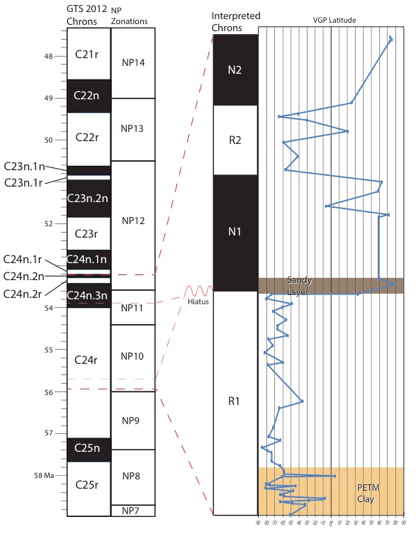Reports: UR853255-UR8: Magnetostratigraphy of the Lodo Formation and Kinematics of the Vallecitos Syncline, California
Christopher J. Pluhar, PhD, California State University, Fresno
This report details findings during year three of this grant, awarded to study the Lodo Formation, a petroleum-bearing unit in the California Coast Ranges. The grant has been granted a one-year no-cost extension by ACS PRF permission.
This marine Lodo Formation was deposited on the continental slope during the late Paleocene and early Eocene epochs and consequently records the Paleocene-Eocene boundary, a time of benthic extinction. Abundant evidence shows that this boundary and extinction coincide with major greenhouse gas emissions to the atmosphere and climatic warming (Zachos et al., 2005 and the references therein), called the Paleocene-Eocene Thermal Maximum (PETM). The grant proposal outlined three main objectives: 1) test the hypothesis proposed by Lee and Kodama (2009) that a paleomagnetic normal polarity subchron occurred coincident with the PETM, 2) produce a magnetostratigraphy of the Lodo Formation type section, 3) sample multiple localities of the Lodo Formation along the Vallecitos Syncline to assess timing of the curvature of the fold axis. In year one, we completed objective 1 (and thus we will not repeat that content). During year two, we made significant progress towards objectives 2 and 3. In year three we made further progress on objective 2 though did not complete the project due to difficulty in student recruiting.
Objective 1 – Test for normal subchron at the PETM. This part of the project was completed during project years 1 and 2. We found no evidence at the Lodo formation type section to support Lee and Kodama's (2009) hypothesis of a normal polarity subchron coinciding with the PETM hyperthermal event.
Objective 2 - Magnetostratigraphy of the Lodo Formation. During project year 3, we completed paleomagnetic analysis ~50 samples from the Lodo Formation type section, that were collected during year 2. We also extended the magnetostratigraphy upsection, collecting ~30 new samples and conducting stepwise thermal demagnetization experiments on them up to 580°C (the blocking temperature of magnetite). We will complete their demagnetization (and conduct additional sample and analysis) during the one-year extension. To date, we have sampled a stratigraphic section for the Lodo Formation type section consisting of ~170 samples that spans: 1) geomagnetic polarity chrons mid-to-upper C24r, all of C24n and probably lower C23, and 2) calcareous nanoplankton zones NP10, NP11, and lower NP12. The sampled section thus records ~53-56 Ma, including one major hiatus at a sandy zone and one possible fault break in the section. In project year 3 we also undertook sampling and analysis for grain-size variation as supplemental data to support our age model.
Objective 3 - Assess Timing of Curvature of the Vallecitos Syncline. We made no significant progress on this objective during project year 3
Ogg, J.G., 2012, The Geomagnetic Polarity Timescale: The Geologic Timescale 2012, ed: Gradstein, F.M., Ogg, J.G., Schmitz, M.D., and Ogg, G.M., pp. 85-114.
| Figure 1 - Preliminary Magnetostratigraphy through the Lower Eocene at Lodo Formation Type Section. We tentatively identify several polarity zones and stratigraphic features. The PETM dissolution clay is shown. The nanoplankton biostratigraphy assists with creating an age model. Timescale from Ogg (2012). |

 |











